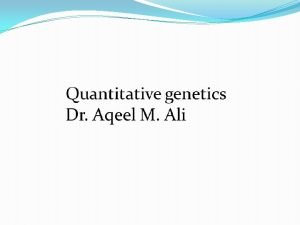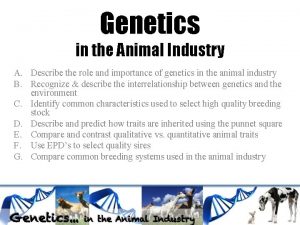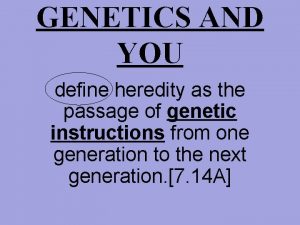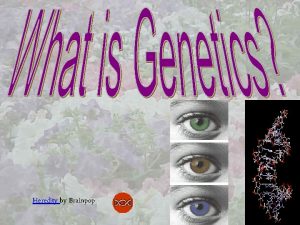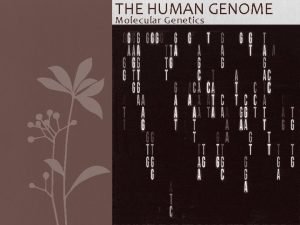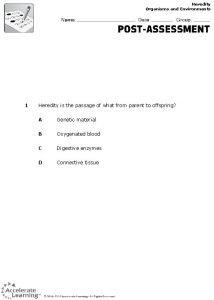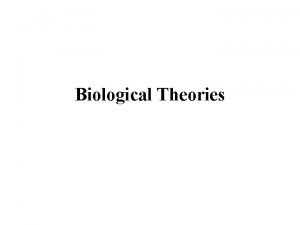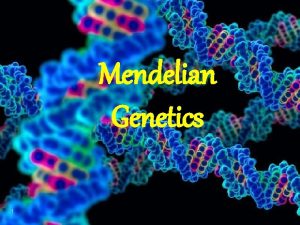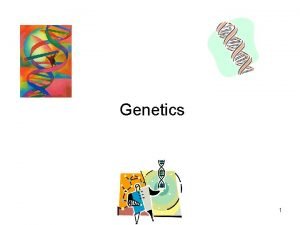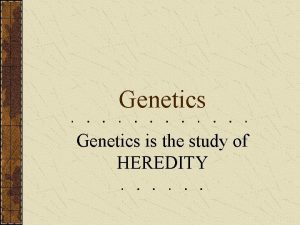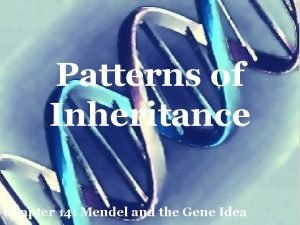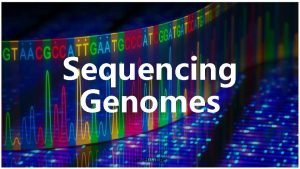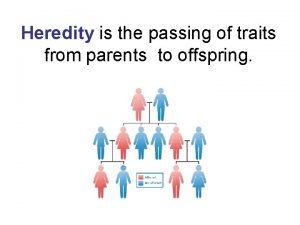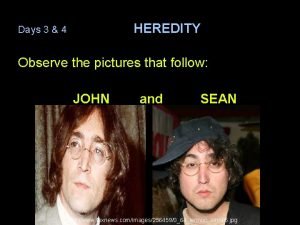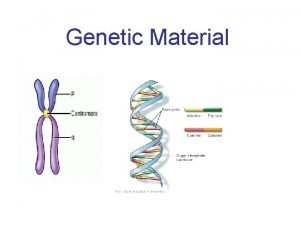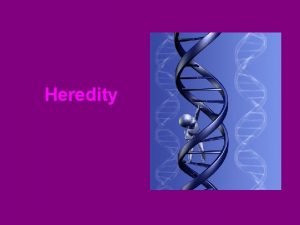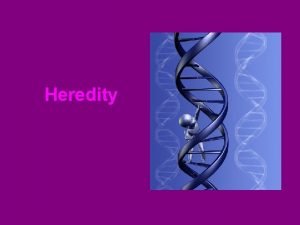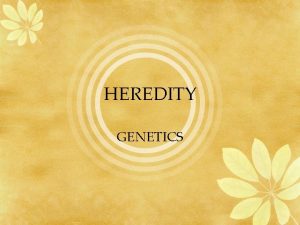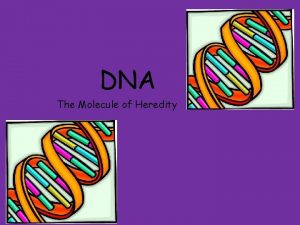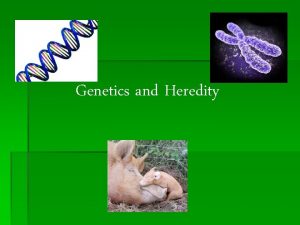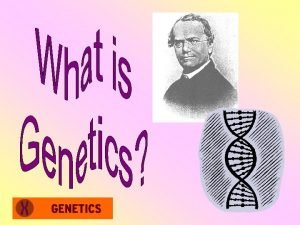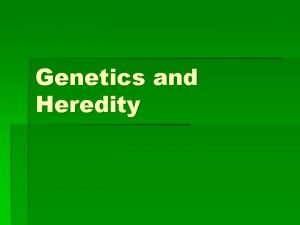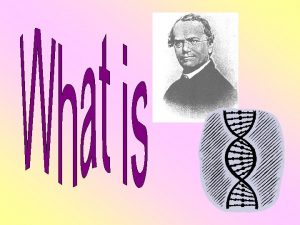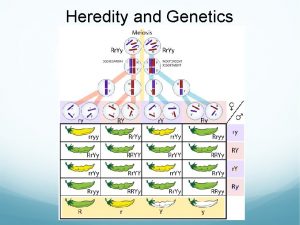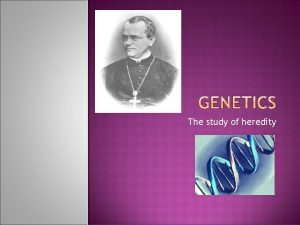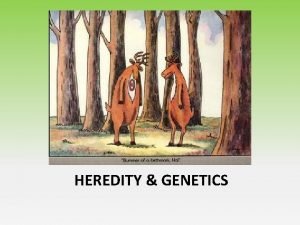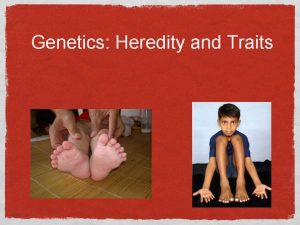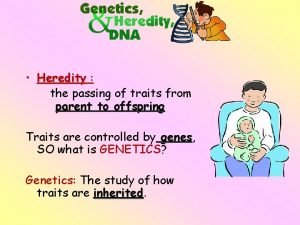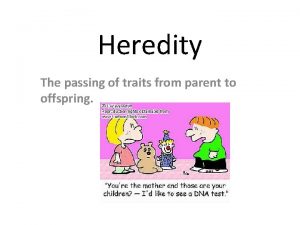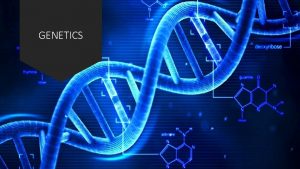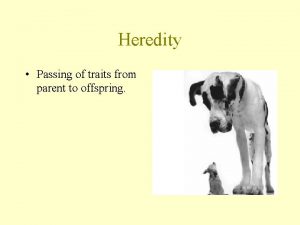Heredity is the passing of traits from parent




















- Slides: 20

Heredity is the passing of traits from parent to offspring. Heredity is responsible for how you have your mother’s eyes and your father’s smile. Along with this inherited similarity though, there is also variation, as we are not exact clones of our mothers and fathers.

Offspring are the new organisms produced by one or more parents. (children, babies, young)

The study of heredity in biology is called genetics.

The Father of Genetics Gregor Mendel was an Austrian monk who studied mathematics and science but became a gardener in a monastery.

• Mendel thought there might be a connection between the color of a pea plant flower and the type of seed the plant produced. • He began to experiment with garden peas in 1856. • Mendel made careful use of experimental design to study pea plants and had the first recorded study of how traits pass from one generation to the next.


Asexual Reproduction • Requires only one parent • Offspring have 100% the same chromosomes as the parent. – In other words, the offspring are exact “clones” of the parent. – Mitosis – Movie

Asexual Reproduction Advantages: • Animals that remain in one particular place and are unable to look for mates would need to reproduce asexually. • Numerous offspring can be produced without "costing" the parent a great amount of energy or time. This type of reproduction is also faster. • Environments that are stable and experience very little change are the best places for organisms that reproduce asexually. Disadvantages: • Lack of genetic variation - all of the organisms are genetically identical and therefore share the same weaknesses. • If the stable environment changes, the consequences could be deadly to all of the individuals. *Animals are not the only organisms that reproduce asexually. Yeasts, plants, and bacteria are capable of asexual reproduction as well.

Sexual reproduction: a type of reproduction in which two cells, usually an egg and a sperm, join to form a new organism with its own genetic identity. Animal Plant

Sexual Reproduction • Sexual Reproduction results in a variety of off spring. powerofpeace. com

Sexual Reproduction Advantage: • Allows genetic variation within a species which assists with the species survival Disadvantages: • Requires 2 parents • Reproduction is slower

Sexual Reproduction • Most members of the Animal Kingdom – Fish – Mammals – Amphibians – Birds – Reptiles – Insects – Crustaceans

Sexual Reproduction • Examples of organisms that reproduce sexually – Chickens – Iguanas – Lobsters – Sharks – Humans – Butterflies – Sunflowers – Roses

Sexual Reproduction • Happens 2 ways – Internally (inside) • The egg is fertilized by sperm inside the female – Mammals, birds, reptiles, insects, spiders – Externally (outside) • The egg is fertilized by sperm outside the female • The female lays the eggs and then the male fertilizes them. – Fish and some amphibians – Plants and fungi (pollen and spores)

Asexual Reproduction • Examples of organisms that reproduce asexually – Hydra – Sea Star – Strawberry – Eubacteria – Euglena – Paramecium – Yeast

Types of Asexual Reproduction • Fragmentation is where a single parent breaks into parts that regenerate into whole new individuals. Ex. Planaria

Types of Asexual Reproduction • Vegetative Propagation (Plant cuttings) • http: //leavingbio. net/VEGETATIVEPROPAGATION. htm Vegetative reproduction is a type of asexual reproduction in plants where new parts grow from parts of the parent plant. It has long been used in horticulture and agriculture. Ex. Spider Plant

Types of Asexual Reproduction • Binary Fission – Bacteria – Protists Binary fission is a form of asexual reproduction where every organelle is copied and the organism divides in two.

Types of Asexual Reproduction • Budding • Movie Budding is where a new individual develops from an outgrowth of a parent, splits off, and lives independently.

Types of Asexual Reproduction • Regeneration occurs when a body part has broken off and the organism grows a new one. Ex. Lizard Tail *The ability to restore lost or damaged tissues, organs or limbs
 Qualitative traits vs quantitative traits
Qualitative traits vs quantitative traits Qualitative traits vs quantitative traits
Qualitative traits vs quantitative traits Quantitative traits
Quantitative traits Heredity is the passage of
Heredity is the passage of A gene carries the for a trait brainpop
A gene carries the for a trait brainpop Heredity
Heredity Heredity defines the passage of genetic material from
Heredity defines the passage of genetic material from Heredity and crime
Heredity and crime Heredity terminology
Heredity terminology Heredity acrostic
Heredity acrostic ____________ is the study of heredity.
____________ is the study of heredity. Chapter 14 patterns of heredity
Chapter 14 patterns of heredity Sanger sequencing
Sanger sequencing Heredity concept map
Heredity concept map Chromosome
Chromosome Mendelian genetics vocab
Mendelian genetics vocab Heredity
Heredity Pictures of heredity
Pictures of heredity Cpalms heredity tutorial
Cpalms heredity tutorial The basic units of heredity
The basic units of heredity Heredity
Heredity
